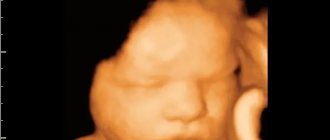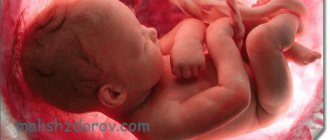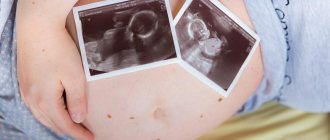The optimal interval between births is considered to be 3–5 years. During this time, the body fully recovers after the first birth, but at the same time it still “remembers” well how to give birth correctly.
The course of repeated births usually differs from the first. The due date for the second pregnancy is most often about a week earlier than for the first. It is difficult to say exactly why this happens: apparently, the body, which has already gone through childbirth once, prepares for it faster. However, this is not necessary, so even if the due date has already approached, and the baby is in no hurry to be born, do not worry. As with the first pregnancy, birth can normally occur between 38 and 42 weeks.
Features of the second birth
Start of labor
The differences begin already from the preparatory period. During the second birth, there may be no preparatory contractions (these are weak, painless contractions that a woman feels a few days before giving birth; such contractions differ from labor contractions primarily in that they do not lead to the opening of the cervix). In addition, during the second pregnancy, such a symptom as some drooping of the abdomen before childbirth is usually not expressed (during the first pregnancy, 1–2 weeks before childbirth, the abdomen usually lowers; some women feel that it has become easier to breathe).
The second birth may begin differently than the first time. For example, if during the first birth a woman’s water first leaked, and then contractions began, then this time everything can happen the same way, or maybe vice versa: there are no patterns here.
The opening of the cervix during repeated births does not occur in the same way as during the first. During the first birth, the cervix first takes on a conical shape, gradually smoothes out, and then begins to dilate. During repeated births, the cervix is cylindrical in shape, it simultaneously shortens and opens. Moreover, the speed of dilatation is usually faster (during the first birth - approximately 1 cm/h, and with repeated births - 1.5–2 cm/h). Therefore, even if the first birth was long, it is better to go to the maternity hospital when the first contractions appear.
Duration of labor
The birth canal, through which a child has already passed once, is more elastic and stretches better, since after the first birth they are already prepared for the birth of the baby. Consequently, the fetus passes through the birth canal faster. Therefore, during the period of pushing, less effort is required to give birth to a child than for the first time. In addition, the woman already knows what sensations she experiences, when and how to push correctly, and it is much easier for her to correctly direct her efforts, which makes pushing more effective. Thanks to this, the overall duration of labor is shortened. If the first birth lasts on average 10–12 hours, then the second birth is shortened to 6–8 hours. The contraction period lasts about 6–7 hours, the pushing period (from full dilatation of the cervix to the birth of the child) is 15–30 minutes, the afterbirth period (from the birth of the child to the discharge of the placenta) is 10–30 minutes. For women giving birth to their first child, the duration of the first stage of labor is 8–10 hours, the second period is 1–2 hours. But the duration of the third (successive) period during the first and subsequent births is approximately the same.
Woman's feelings
Contractions during the second birth are sometimes more painful than during the first. After the first birth, the nerve endings in the uterus become more sensitive, and contractions immediately become quite intense. Nevertheless, subjectively, women in most cases endure the second birth easier, since the first time the pain increases due to fear and anxiety, and during the second birth these negative emotions are much less expressed.
Most women note that the second birth was easier, even if many years passed between births. This is explained not only by the shorter duration of the process, but also by a decrease in fear of childbirth. During the first birth, due to fear, the woman often clamps down; during the second birth, this usually does not happen, so the contractions are more effective. In addition, women already know better what to expect, how to behave, how to breathe correctly, which positions are best to take and what to do during different periods of labor.
Newborn weight
There is an opinion that with repeated births the child is larger, but this is not true: there is no such pattern, just like the reverse. The weight of the child is often not related to the serial number of births as a result of which he was born. Although there are observations indicating that with repeated births, babies are born with a slightly higher weight. This may be due to the fact that during the second pregnancy, the uteroplacental blood circulation is more intense.
Planning a 2nd pregnancy: what should you consider?
If a woman is already a happy mother of one baby, pregnancy and subsequent childbirth, of course, will no longer be new to her. However, planning also has its own peculiarities for those who are preparing specifically for second motherhood.
When planning a second child, a woman should consider:
- Psychological readiness (there must be a firm affirmative answer to the question: is the woman ready to go through painful childbirth, sleepless nights, etc. again).
- Physiological readiness (since pregnancy is considered a huge stress for a woman’s body, it needs time to completely “reboot” before the second conception).
- Age difference between children.
- Aggravating factors (caesarean section during the first birth, age over 30 years, negative Rh of the mother’s blood).
- Unplanned risk factors, for which it is also better to prepare (mentally and physically) in advance.
Second birth: possible complications
Complications during repeated births are usually less common. However, complications that arose during the first birth can, although not necessarily, recur.
Ruptures during repeated births are much less common than during the first. If there were ruptures in the first birth, then another rupture may occur in the same place, although this does not happen often. We can say that if the scars at the site of ruptures in the vagina and perineum healed well, then they will not lead to ruptures during repeated births. Cervical ruptures recur more often, since stretching of the cervix at the site of the scar left after the rupture is difficult. Ruptures of the perineum and vagina may recur if the last time there was suppuration in the area of the sutures. Tears may occur at the site of a previous episiotomy (cut in the perineum), but if the suture has healed well, this usually does not happen.
Weakness of labor is less common during the second birth, even if it was present during the first birth, so doctors are less likely to resort to stimulation. This is explained by the fact that the weakness of labor is often due to the woman’s fear and lack of preparation for childbirth. However, if the expectant mother is over 35 years old, then the likelihood of this complication increases. Weakness may also recur if it was caused by a chronic illness of the mother (hypertension, heart defects, bronchial asthma with respiratory failure). The older a woman is and the more chronic diseases she has, the more likely she is to develop weakness in labor. The risk of labor weakness is also increased in women who have a short interval between births, since the muscles of the uterus and abdominal muscles are not always fully restored during this time. Muscles recover more slowly in case of multiple pregnancy (in the current or previous pregnancy), polyhydramnios, and also in the case of a large fetus. All these factors lead to muscle overstretching, and the ability to contract is reduced.
If during the first birth there were difficulties with the separation and release of the placenta and they resorted to manual separation of the placenta, there is a high probability that the second time the placenta will not separate on its own. This probability increases if after the first birth there were inflammatory diseases of the uterus (endometritis) or if the woman had abortions or miscarriages between births.
However, even if there were no complications during the first birth, they may occur the second time, especially if many years have passed between births and the woman has managed to “accumulate” chronic diseases. The frequency of complications during repeated births is also increased by abortions and miscarriages between births, and sexually transmitted infections.
Rh conflict during pregnancy
Many women with the onset of a second pregnancy are faced with the concept of Rh conflict. The Rh factor is a protein called an antigen that is found in the red blood cells of 85% of people. Such people are considered Rh positive. The rest of the population (15%) does not have this protein and are considered Rh negative. In everyday life, the presence or absence of Rh protein does not manifest itself in any way. Rh conflict during pregnancy can develop when Rh-positive red blood cells of the fetus enter the bloodstream of the Rh-negative mother.
So, if the expectant mother has Rh-negative blood and the father has Rh-positive blood, their common child may have Rh-positive blood. It should be noted that in this case, in the first pregnancy, no complications due to Rh conflict, as a rule, arise. The mother's immune system will begin to produce antibodies (protective proteins) to the Rh factor. However, these antibodies, due to their structure and small amount, do not penetrate the placenta, and therefore cannot have any effect on the fetus. After such a meeting, “memory cells” are formed in the mother’s immune system, which, upon repeated contact (i.e., during subsequent pregnancies), produce antibodies with a different structure, capable of penetrating the placenta and developing Rh conflict. Rh conflict may occur during the second pregnancy; Moreover, it does not matter that in the mother’s body “memory cells” form antibodies that can develop Rh conflict. The Rh conflict is that anti-Rh antibodies, entering the bloodstream of the fetus, destroy its red blood cells, causing anemia, edema, and dysfunction of vital organs. This condition of the fetus and newborn is called hemolytic disease.
As a rule, a pronounced Rh conflict during pregnancy develops in no more than 10% of cases.
Usually, when registering at the antenatal clinic, all pregnant women are determined by their blood type and Rh factor, and in the presence of negative Rh, the blood type and Rh factor of the father. If a pregnant woman is found to have Rh-negative blood, she is taken into special registration. Starting from the second half of pregnancy, every 3-4 weeks a woman is tested for the presence of Rh antibodies in her blood. In the absence of Rh antibodies, pregnant women with Rh-negative blood are given anti-Rhesus immunoglobulin at the 28th week of pregnancy - this measure prevents the formation of antibodies. If antibodies are detected, blood tests are prescribed more often, and additional ultrasounds are performed if necessary. If hemolytic disease develops in the fetus, treatment is carried out in a specialized hospital.
How to prepare for a second birth
The number of complications during pregnancy and childbirth increases in the presence of chronic diseases. Therefore, if a woman has any chronic diseases, it is important to consult specialists, preferably even before pregnancy, so that they can prescribe treatment in a timely manner aimed at the maximum possible compensation for the disease.
During the second pregnancy, as well as during the first, it is advisable to attend a school for future parents. Many moms think that because they already “know everything” about pregnancy and birth, they don’t need to learn anything else. However, this is a completely wrong position. At the school for expectant mothers, they not only teach about the physiology of childbirth, but also prepare psychologically for childbirth and help create the right mood. This is especially important for women whose first birth was complicated and there is a fear that everything will happen again.
Physical training is also important - gymnastics for pregnant women, swimming pool exercises, breathing exercises. Even if a little time has passed since your first pregnancy, you need to prepare for childbirth every time.
After your first birth, you already have a rough idea of what the conditions of stay are in the maternity hospital you have chosen, and you can answer the question whether you are satisfied with a regular ward or if you want to stay in a superior ward after giving birth. If necessary, enter into a contract in advance for childbirth in the maternity hospital that you choose. It is also possible to conclude a contract so that a specific doctor will be present at the birth. In addition, after the first birth, you can draw a conclusion about how much pain relief you need.
Knowing how labor goes will help you decide whether you will need your husband's help.
Many women say that during their second birth they had a chance to correct all the mistakes made during their first birth. This chance must be taken advantage of.
Psychological preparation
It is difficult for a woman who has experienced a difficult premature birth to be positive. But you need to do this both for yourself and for the child. If you are suffering from anxiety, choose a clinic that will provide birth management the way you want. Talk to your doctor, find out all the details, and don’t hesitate to ask any questions.
Understand the main thing: the second birth is not a copy of the first. As a rule, they proceed more quickly, but this does not affect the gestation period in any way. If you find it difficult to overcome anxiety, talk to a psychologist.
The birth of a child is an exciting event for any family. Prepare for it in advance so that during pregnancy you can direct maximum energy in a positive direction.
Second birth after caesarean section
If the birth was operative the first time, then there is a high probability that a cesarean section will be performed the second time (in our country, more than 90% of women after a cesarean section undergo surgery again). However, at present, in such a situation, birth through the birth canal is also possible. The possibility of independent childbirth is determined by several factors:
- The reason that made me perform the operation for the first time. For example, if the first operation was performed due to an anatomical narrowing of the pelvis, then this reason will not go away the second time. But if the first time the operation was performed due to the incorrect position of the fetus, then the second time this situation may not happen again, and spontaneous childbirth is possible. There can be many indications for a caesarean section, and natural childbirth is possible only if there are no – neither absolute nor relative – indications for surgery.
- Condition of the scar after cesarean section. A scar is considered healthy if its thickness is more than 5 mm (the condition of the scar is assessed by ultrasound in the second and third trimesters of pregnancy) and more than 2 years have passed between pregnancies.
- The condition of the birth canal (maturity of the cervix at the time of full-term pregnancy).
- The mood of the woman herself.











